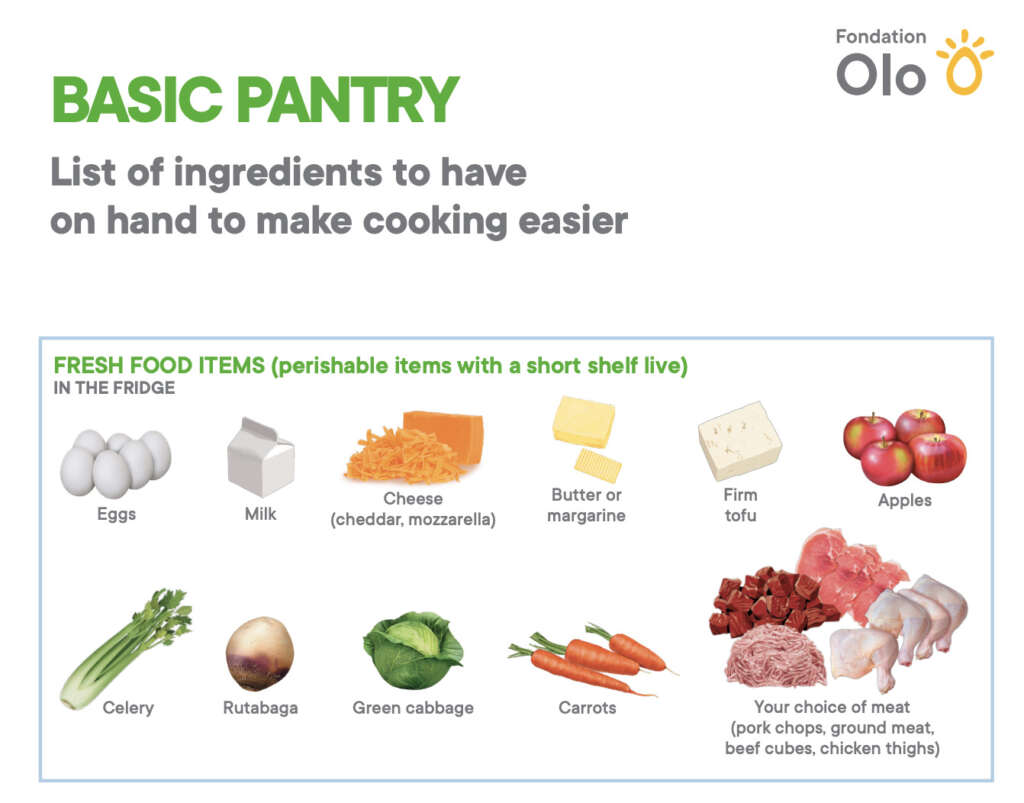Whether you’re just starting to cook or are more experienced, it’s helpful to have some basics—both ingredients and cooking tools—on hand to make healthy, tasty meals.
Food
After a grocery run, your pantry and fridge should contain the ingredients you’ll need to make a variety of meals. Luckily, some foods are inexpensive, available nearly year-round and can be used in a number of recipes.
Tip: Check the best-by (expiration) dates while putting your groceries away. Prevent food waste by placing older products near the front of the fridge or pantry so you use them first.
What are the basic pantry staples to have on hand?
In the fridge:
Some food items don’t keep long and need to be stored in the fridge. These are usually foods you use often in meals and need to be bought more frequently. Since different parts of the fridge have different temperatures, store the foods according to their temperature needs. Here are some tips:
- Meats, tofu, eggs and milk products
They provide the body with protein and are vital to health. They also help hold you over until the next meal and keep you from eating too many snacks between meals.
-
- Raw meat is ideally kept on the bottom shelf. Cold moves downward, making this the coldest part of the fridge. Also, by storing meat at the bottom, other foods won’t get contaminated if the package leaks.
- Cheese and eggs should be kept on the middle shelf.
- Tofu and milk should be kept on the top shelf, to keep them cool.

- Fruits and vegetables
Fruits and vegetables bring colour, vitamins and minerals to your meals and provide variety on your plate.
-
- To keep fruits and vegetables from getting too cold, store them in the specially designed crisper drawers at the bottom of the fridge. It’s the least cold spot because the drawers are insulated.
- Condiments
Condiments include butter, margarine, ketchup, mustard, mayonnaise, hot sauce and soy sauce, among others. They add flavour to meals.
-
- Condiments can be placed in the fridge door, where temperatures fluctuate, because they can easily withstand these changes.
Did you know? Temperatures change the most in the fridge door because every time you open it, warmer air gets in. To keep milk and eggs fresh, avoid storing them in the door compartments.
In the freezer:
Corn, peas, spinach and sole fillets are some of the practical foods you should keep in the freezer to make meal preparation easy. With no skin or peels and already cut in pieces, they are generally ready to use, saving you lots of time!
Frozen foods also give you access to certain foods year-round. They keep much longer and can be a good low-cost choice.
Did you know? Frozen vegetables contain as many vitamins and minerals as fresh ones! They’re great additions to your meals!
In the cupboard or pantry:
Several categories of foods are kept in the cupboard or pantry. Fresh products like potatoes, bread, onions and garlic, but also “dry” foods like pasta and rice, canned goods, baking ingredients, condiments, spices and herbs.
Storing these foods in a cupboard or pantry protects them from light and humidity, which will help them keep for longer.
You can store each category on a different shelf, depending on the space available. For example:
- Potatoes, onions and garlic on one shelf (not touching)
- Canned goods, spices, herbs and condiments on another
- We’re often tempted to keep herbs and spices near the stove. Unfortunately, the light and heat reduce their flavour. For this reason, it’s preferable to keep them in a tightly sealed container in a cupboard.
- Dry foods and bread
- Baking ingredients: sugar, baking powder, baking soda, cocoa powder, etc.
Need inspiration for recipes that use all these ingredients? Good news! You can make most of the Olo recipes with the Basic Pantry ingredients.
Basic kitchen tools
Cooking tools and utensils:
Eating well and cooking doesn’t require a lot of tools, but a few are very handy. Knives, spoons, a spatula, bowls, frying pans, baking dishes and such make day-to-day cooking easier. Here is the list of basic kitchen tools we recommend so you can make plenty of recipes. A very useful list for a well-equipped kitchen!

To prepare a bunch of delicious recipes, all you need are some basic cooking tools and some basic ingredients!
Writing : Fondation Olo
Scientific review : Mylène Duplessis Brochu, nutritionist, Dt.P., M.Sc.
